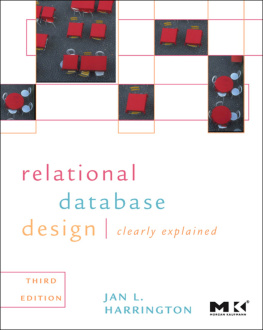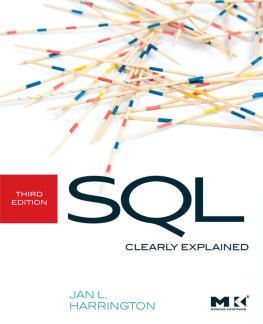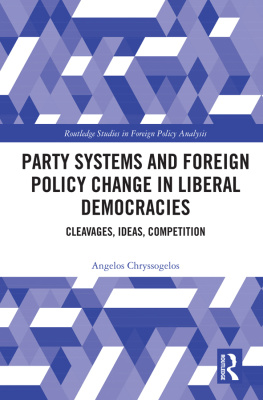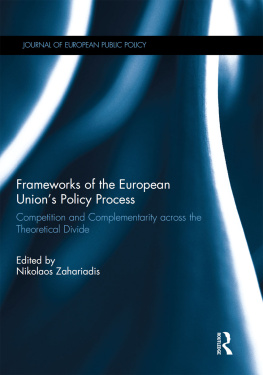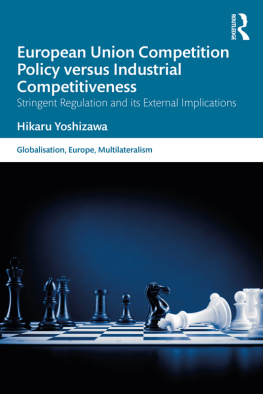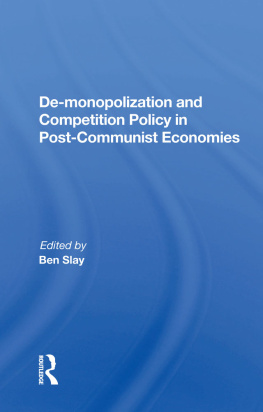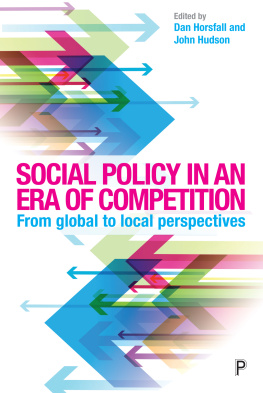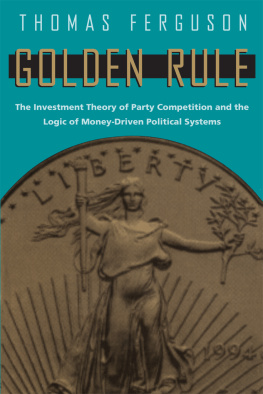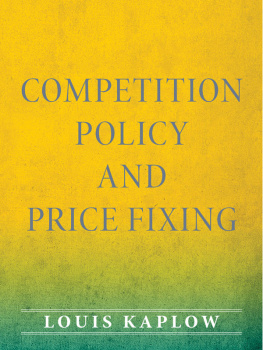Harrington - The theory of collusion and competition policy
Here you can read online Harrington - The theory of collusion and competition policy full text of the book (entire story) in english for free. Download pdf and epub, get meaning, cover and reviews about this ebook. year: 2017, publisher: The MIT Press, genre: Politics. Description of the work, (preface) as well as reviews are available. Best literature library LitArk.com created for fans of good reading and offers a wide selection of genres:
Romance novel
Science fiction
Adventure
Detective
Science
History
Home and family
Prose
Art
Politics
Computer
Non-fiction
Religion
Business
Children
Humor
Choose a favorite category and find really read worthwhile books. Enjoy immersion in the world of imagination, feel the emotions of the characters or learn something new for yourself, make an fascinating discovery.

- Book:The theory of collusion and competition policy
- Author:
- Publisher:The MIT Press
- Genre:
- Year:2017
- Rating:4 / 5
- Favourites:Add to favourites
- Your mark:
- 80
- 1
- 2
- 3
- 4
- 5
The theory of collusion and competition policy: summary, description and annotation
We offer to read an annotation, description, summary or preface (depends on what the author of the book "The theory of collusion and competition policy" wrote himself). If you haven't found the necessary information about the book — write in the comments, we will try to find it.
The theory of collusion and competition policy — read online for free the complete book (whole text) full work
Below is the text of the book, divided by pages. System saving the place of the last page read, allows you to conveniently read the book "The theory of collusion and competition policy" online for free, without having to search again every time where you left off. Put a bookmark, and you can go to the page where you finished reading at any time.
Font size:
Interval:
Bookmark:
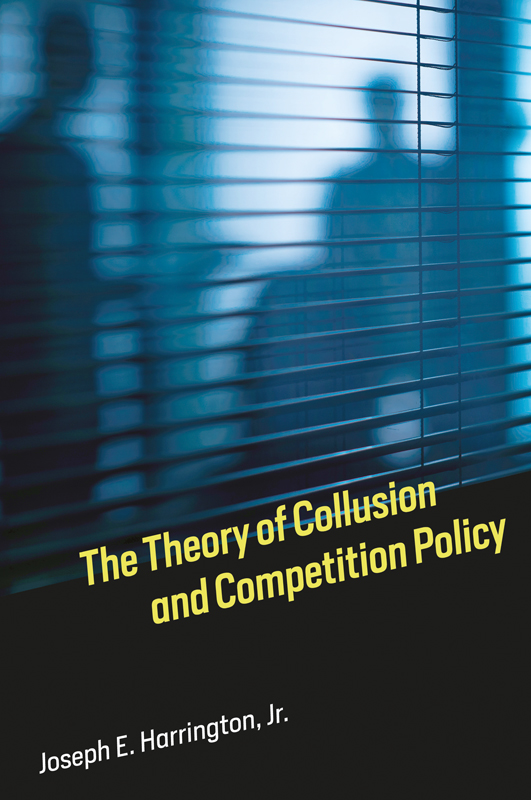
The Theory of Collusion and Competition Policy
Joseph E. Harrington, Jr.
The MIT Press
Cambridge, Massachusetts
London, England
2017 Massachusetts Institute of Technology
All rights reserved. No part of this book may be reproduced in any form by any electronic or mechanical means (including photocopying, recording, or information storage and retrieval) without permission in writing from the publisher.
This book was set in Times Roman by Westchester Publishing Services. Printed and bound in the United States of America.
Library of Congress Cataloging-in-Publication Data
Names: Harrington, Joseph Emmett, 1957 author.
Title: The theory of collusion and competition policy / Joseph E. Harrington, Jr.
Description: Cambridge, MA: The MIT Press, 2017. | Includes bibliographical references and index.
Identifiers: LCCN 2017010722 | ISBN 9780262036931 (hardcover: alk. paper)
Subjects: LCSH: Industrial policy. | Trade regulation. | Price fixing. | Competition. | Antitrust lawEconomic aspects.
Classification: LCC HD3612.H37 2017 | DDC 338.6/04801dc23
LC record available at https://lccn.loc.gov/2017010722
To the memory of my father. For his optimism, his good cheer, his integrity, and his taste for beer.
List of Figures
Effect of the discount factor on equilibrium price path.
Collusive and noncollusive price paths.
This book reviews the theory of unlawful collusion, which means there is a competition law and firms are colluding in a manner that violates that law and, if convicted, they will be penalized. The book is designed to bring the reader up to speed on the questions posed, the models constructed, and the results and insight derived, as well as identifying topics in need of research. The intended audience is economics scholars who seek to contribute to our understanding of how unlawful collusion operates and the proper design of competition law and enforcement or those who just want to learn about these topics. Doctoral economics students are particularly welcome, and I encourage them to look for the gaps in the literature that could be the source of a thesis topic.
The reader is presumed to have at least a rudimentary understanding of the theory of collusion grounded in the theory of repeated games. Suitable treatments at the masters level are provided in Tirole (1988) and Motta (2004), while Vives (1999) is at the doctoral level. If, before taking a ramble through the wilds of economic theory, the reader would like to have some facts about how cartels are structured and the practices that they deploy, I recommend Harrington (2006) and Marshall and Marx (2012). Marshall and Marx (2012) is an innovative treatment designed for practitioners, both lawyers and economists, though it is also of considerable value to scholars. Harrington (2006) is well suited for those seeking institutional and factual grounding before venturing into the theory of collusion in that its coverage of collusive practices is organized around the primary theoretical constructs.
I acknowledge the comments of an anonymous referee, participants at the Legal and Illegal Cartels Conference (ZEW, Mannheim, December 2015), where a preliminary version of this book was presented as a keynote address, and the National Science Foundation (SES-1148129) for financial support.
.United States v. Topco Assocs., 405 U.S. 596, 610, n. 10 (1972).
Collusion is when firms in a market coordinate their behavior for the purpose of producing a supracompetitive outcome. A supracompetitive outcome is one in which price exceeds the price that would have occurred without the coordination among firms. In the economic theory of collusion, coordination is with respect to the strategies that firms use. A firms strategy prescribes its behavior (e.g., what price to set, how much to produce), and that behavior can be contingent on what has transpired in the market (e.g., the prices that firms recently charged) as well as on current market conditions (e.g., a firms cost and the strength of market demand). In laymens terms, the definition of collusion put forth by economic theory is:
Collusion is when firms use history-dependent strategies to sustain supracompetitive outcomes through a reward-punishment scheme that rewards a firm for abiding by the supracompetitive outcome and punishes it for departing from it.
If a firm abides by the collusive outcomewhich could involve high prices, exclusive territories, customer allocation, and so forththen it is rewarded in the future by rival firms continuing to abide by the collusive outcome (e.g., persisting with high prices); while if it departs from the collusive outcome (e.g., setting a low price, selling above its quota, serving another firms customers) then it is punished in the future by rival firms acting aggressively to reduce the deviating firms profits (e.g., lowering prices, selling to the deviating firms customers). Collusion involves an implicit or explicit understanding among firms that ties future rewards and punishments to current behavior and, by doing so, is able to induce compliance with regard to the supracompetitive outcome. This understanding can be viewed as contractual, though the penalties for acting contrary to the terms of the contract take the form of rival firms future (disciplining) behavior. For this arrangement to be effective, it must be self-enforcing, which means that each firm finds it in its best interest to abide by the arrangement as long as all other firms are expected to do so.
A collusive strategy comprises three fundamental elements. First, it describes the collusive outcome, such as what common price is to be charged or which firm is to serve which geographic area (when the scheme involves exclusive territories). Second, it describes the monitoring protocol; that is, how firms will monitor one another for compliance with the collusive outcome. If prices are observable and the collusive outcome is to set a common high price, then monitoring could be in terms of past prices. However, if the firms supply an intermediate good to industrial buyers (e.g., cement suppliers selling to construction companies) where price can be privately negotiated between a seller and a buyer, then price monitoring will not work. In that case, the supracompetitive outcome could involve an allocation of sales quotas (along with a common price to be set), with monitoring taking the form of comparing realized sales to those sales quotas. Third, the collusive strategy describes the punishment that occurs when there is evidence of noncompliance. Among other possibilities, the punishment could be a temporary or permanent reversion to pricing competitively, or it could be a focused price war that has firms charge low prices for the customers of the firm that apparently deviated.
Let us now state more formally, in the jargon of game theory, the meaning of firms in a market coordinate their behavior for the purpose of producing a supracompetitive outcome. As the competitive benchmark is typically defined to be a Nash equilibrium outcome for some static oligopoly game, a supracompetitive outcome involves higher prices than for a static Nash equilibrium. Coordination on a collusive strategy in a game-theoretic framework is taken to be a subgame perfect (or sequential) equilibrium in a repeated game (where the stage game is the original static oligopoly game), which produces supracompetitive outcomes through the use of history-dependent strategies. More specifically, an outcome with higher prices and profits is sustained by the threat that noncompliance with that outcome (or evidence consistent with noncompliance) is punished with a low continuation payoff, such as a temporary or permanent reversion to a stage game Nash equilibrium, or a finite number of periods with low prices and subsequent return to prices exceeding static Nash equilibrium prices.
Font size:
Interval:
Bookmark:
Similar books «The theory of collusion and competition policy»
Look at similar books to The theory of collusion and competition policy. We have selected literature similar in name and meaning in the hope of providing readers with more options to find new, interesting, not yet read works.
Discussion, reviews of the book The theory of collusion and competition policy and just readers' own opinions. Leave your comments, write what you think about the work, its meaning or the main characters. Specify what exactly you liked and what you didn't like, and why you think so.

